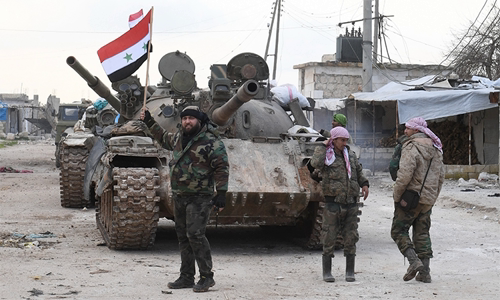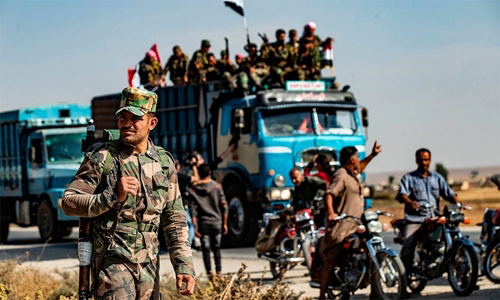The Syrian army suffered many losses after constant battles, and the change in the recruitment policy caused the force to decline significantly.
The Turkish army said on March 6 it had killed 21 Syrian army soldiers in response to the deaths of two Turkish soldiers during the attack the day before in Idlib province, northwestern Syria. Two cannons and two rocket launchers of the Syrian army were also destroyed by Turkey in this "revenge" attack.

Syrian military convoy stops near the Damascus-Aleppo highway in Aleppo province on 10 February Photo: AFP
It was a devastating loss for the Syrian Arab Army (SAA), which lost 309 people in Turkish air strikes and shelling on February 27, after 39 Turkish soldiers died. because it was hit by a Syrian air force. The continuous losses of lives and weapons made the Syrian government army seriously deprived.
Before the civil war broke out in 2011, the Syrian army had about 220,000 regular soldiers, considered to be one of the leading military forces in the Middle East. However, after many years of constant fighting against the rebels and the Islamic State (IS) self-proclaimed, due to various reasons, this force only has a few divisions capable of fighting, of which regular soldiers make up only a small part.
The casualties caused the Syrian army to lose most of its operational capability. The 9-year war left SAA suffering over 100,000 casualties. The Syrian Ministry of Defense said nearly 185,000 servicemen and militia were disabled by the war.
Before Russia's military intervention in Syria in 2015, the SAA was constantly under the pressure of rebels and ISIS, making defection very common. Some estimates suggest that about 190,000 Syrian soldiers have left the ranks after fierce battles.
Such large-scale defections and defections make the Syrian government question the loyalty of the military, especially Sunni soldiers, who are the majority in the country.
The end of the recruitment policy from the Sunni Muslim community has made the Syrian army unable to compensate for the manpower lost in combat. All of SAA's 20 regular divisions were inadequate, in fact only the size of a brigade with 2,000-4,000 men.
This situation forced the SAA to reorganize its forces in consultation with the Iranian Revolutionary Guards (IRGC), which is to build units in a religious and political way similar to Islamic militant groups, instead of regular military unit. As a result, Syria formed the National Self-Defense Force (NDF), a volunteer militia group modeled after the IRGC Basij General Mobilization Corps.
In addition to Islamic militant groups, the Syrian government authorizes Alawis businessmen loyal to President Bashar al-Assad to build a private armed force with better equipment and wages.
The reliance on private security forces and militant groups to fill the void led to the disintegration of the Syrian military command system, which operates independently of the SAA officers. The ability to co-operate in the operations was broken, the Syrian government forces moved in discrete, unconnected.
In Idlib's 2018 offensive against militants, Iranian-backed militias did not engage in the fighting but were stationed in safe positions along the border with Iraq, leaving the Syrian army alone to act. Experts said that if Iranian militants participated in this operation, the last rebel stronghold in northwestern Syria could have collapsed two years ago.

Syrian soldiers arrived in Tal Tamr town after an agreement with the Kurdish government in October 2019 Photo: AFP
The Syrian army also suffered irreparable losses after repeated battles. In 2011, SAA owned nearly 3,000 tanks, about 50% of which were T-72 and some older tanks such as T-54, T-55 and T-62. However, during the first 6 years of the war, the SAA lost more than 2,000 tanks, mainly due to the rebel anti-tank missiles, especially TOW missiles provided by the US.
Before the civil war, the Syrian Air Force owned about 500 fighter aircraft and helicopters, mainly including MiG-21 fighters, MiG-21 bombers, Su-22 and Su-24 attackers. So far, this force has lost at least 4 Su-24, 18 Su-22, 22 Su-23, 23 MiG-21 fighters, 22 L-39 training aircraft, many helicopters and 15 jet fighters of unknown type.
The rebels claimed to have shot down up to 200 Syrian airplanes, killed or taken prisoners as many pilots. The remaining aircraft of the Syrian Air Force are concentrated in five large bases, each with just over 10 jet fighters.
In a recent clash in Idlib province, the Turkish army defeated two Su-24 attackers and a Syrian L-39 training aircraft. The Syrian army also lost 8 helicopters, 135 tanks and 77 armors during the fighting.
The Syrian army was restructured after Russia deployed forces in the country in September 2015. In the Latakia offensive, Syria formed the Fourth Assault Corps, based on the remaining forces of Military Region 3 and 4 and at least 6 private security brigades of Alawis led by the Syrian Republican Guard. .
Syrian government forces are supported by two regiments and two Russian artillery brigades. The mechanized and naval infantry brigades join Russia in providing logistical support and as a backup force.
In addition to the Syrian government forces, there are four Russian Spetnaz brigades, two Tiger and Leopard special forces units of the Alawis businessman, many IRGC brigades and 65 65 air force brigades, and many brigades. Iraqi militia.
Before the mighty army of foreign forces, the Syrian regular army became inferior when there were no more than 70,000 soldiers under the direct command of President al-Assad.
With the deteriorating or damaged military facilities, the loss of manpower and equipment makes the Syrian army no longer capable without the allied forces present in the Middle East country because their interests, military experts said.



 GoldySharma
GoldySharma







